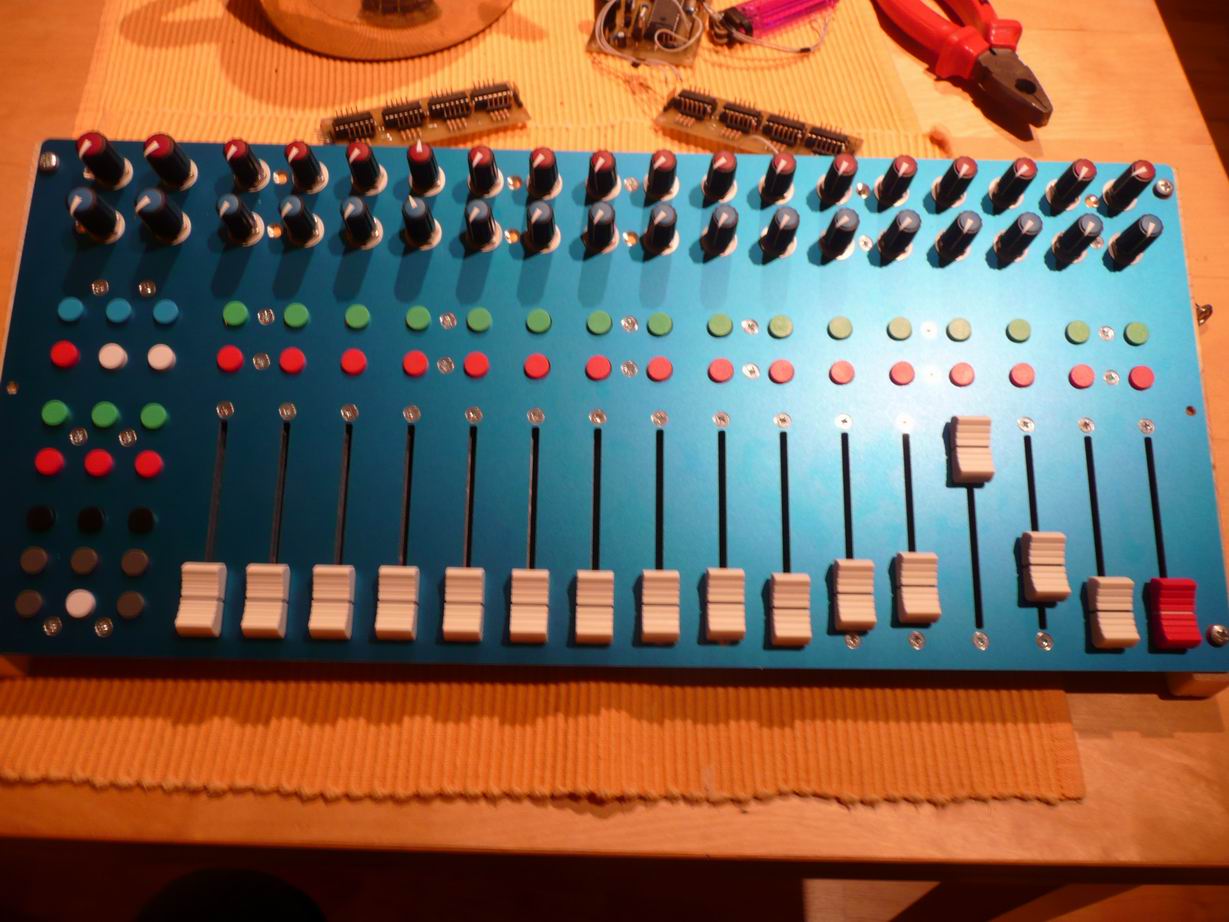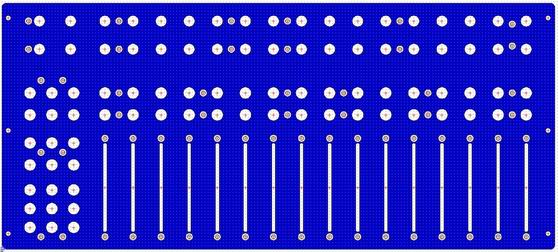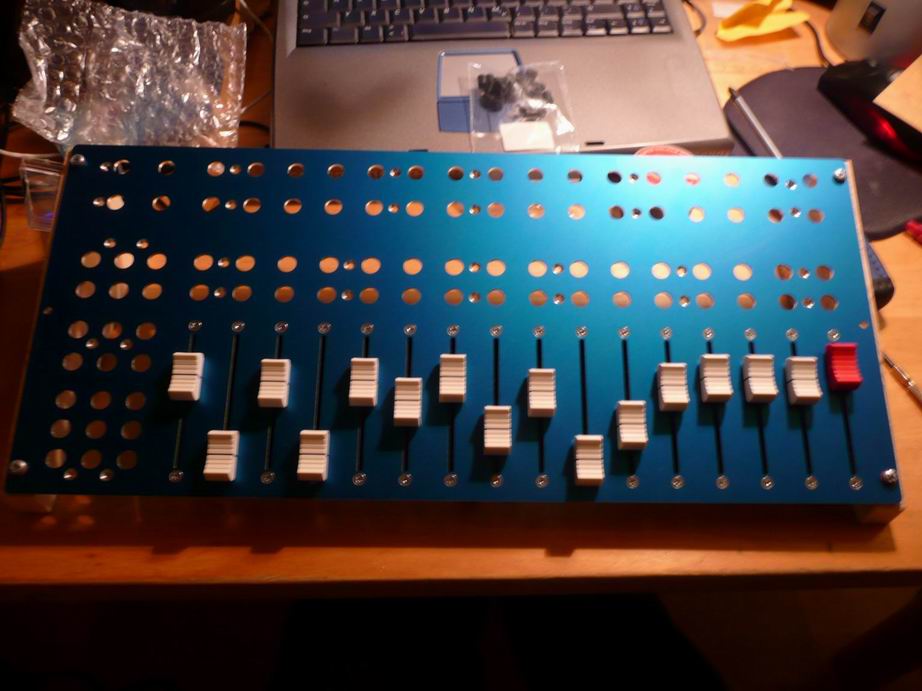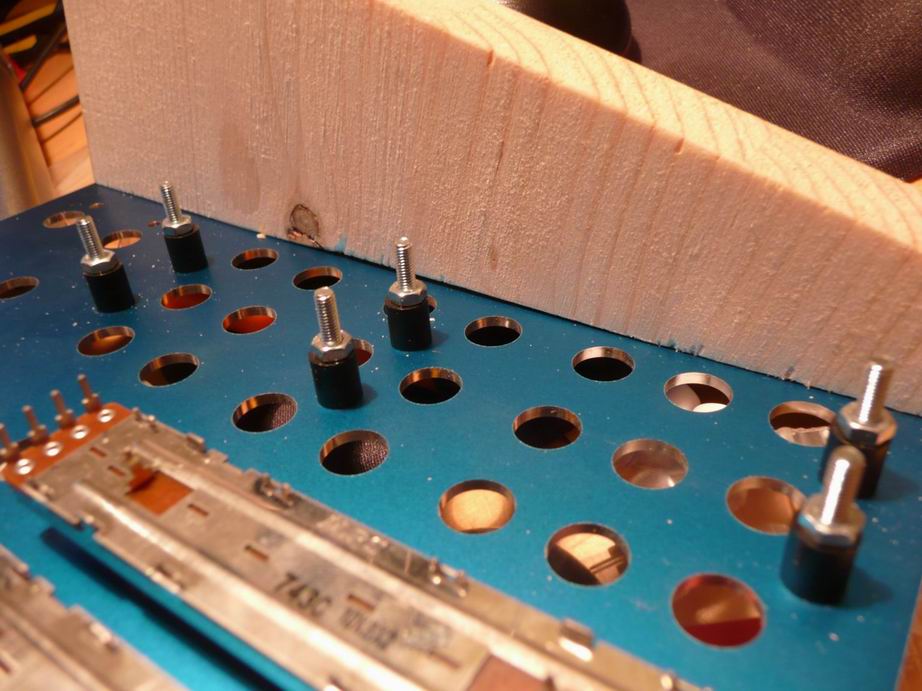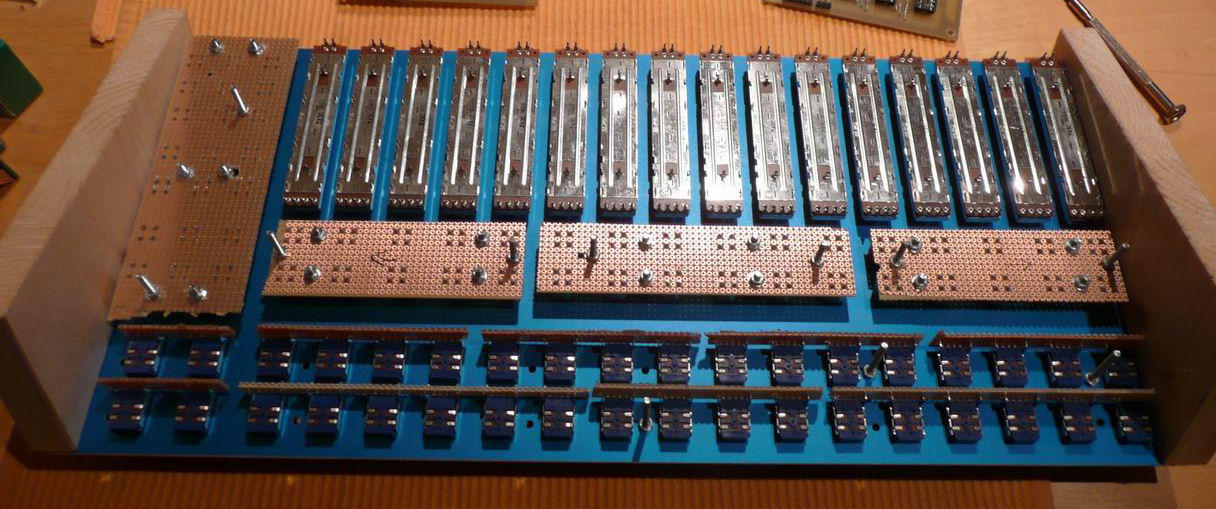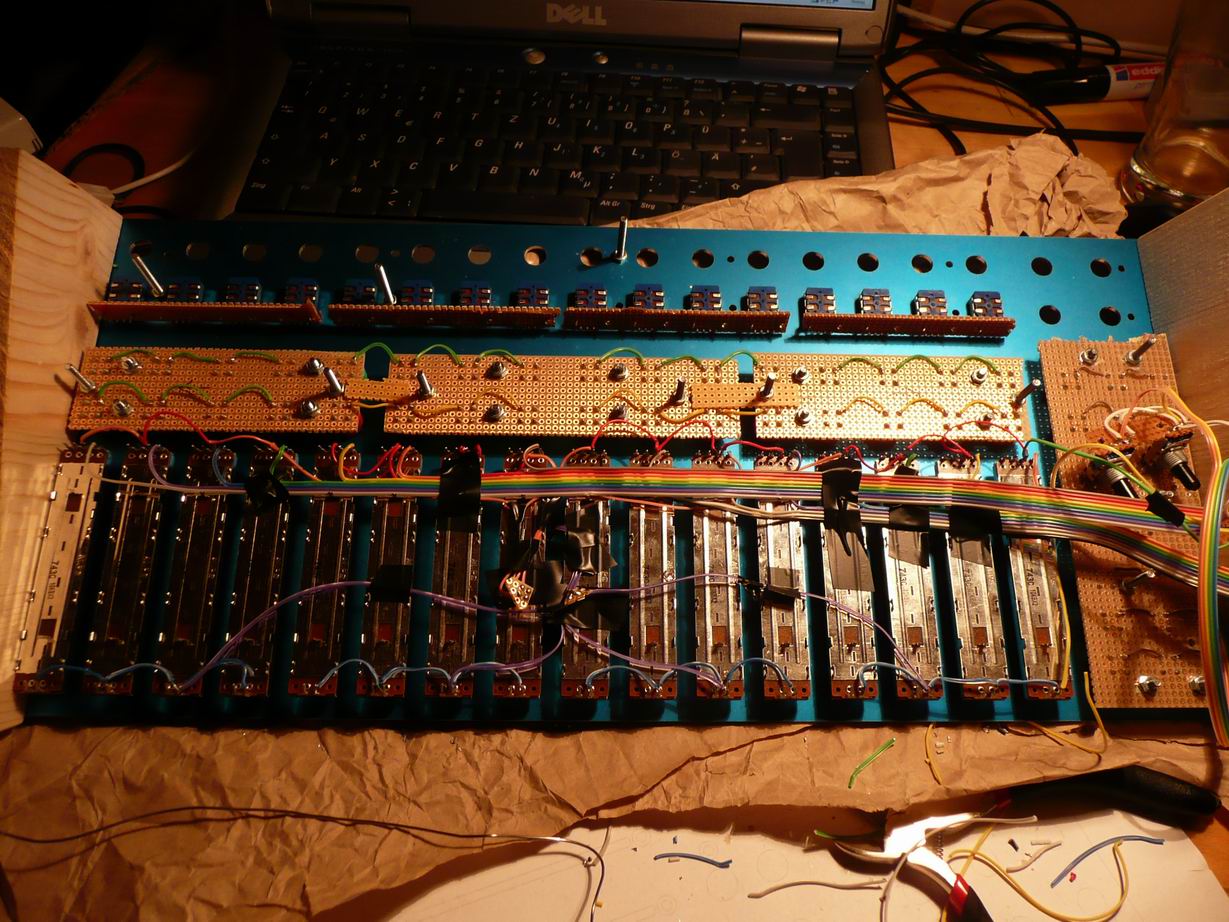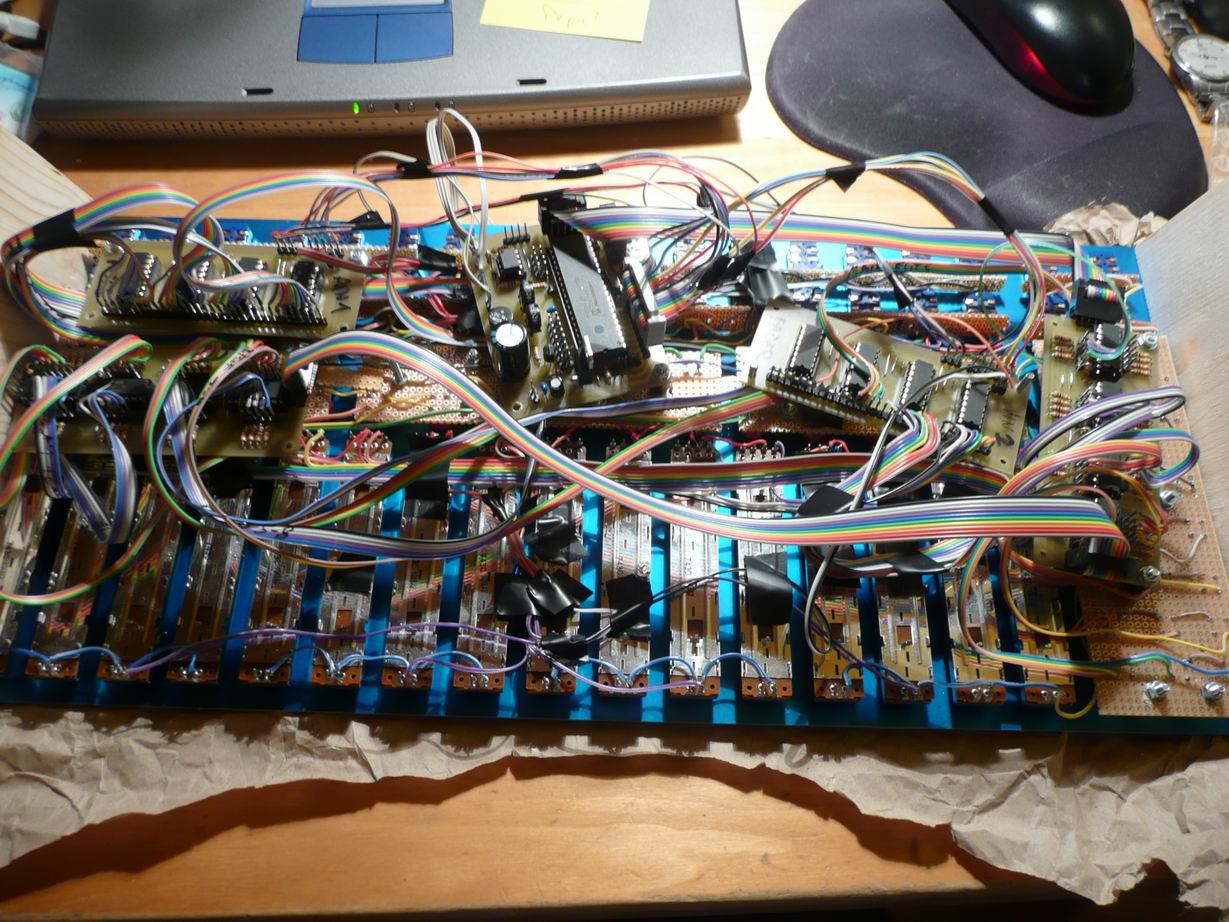Table of Contents
StuKontrol - a MIDIbox64 project
Idea and Development
Background
The idea to develop the StuKontrol is based on my first experiences using a MIDI controller to control Ableton Live in Session View to “perform” tracks in a live way. This first approach was with the Evolution UC-33, which had 8 “channels” with a little fader and 3 pots each. That was about 4 years ago. On the UC-33 the number pad could also be used to trigger MIDI CCs/Notes, this is where I got the idea to control the track in a more global way (different parts, breakdowns, drum rolls etc.) However, working with the UC-33 was not fully satisfying, as i couldn't figure out a proper way to trigger the clips in each channel. Also, the UC-33 i bought on ebay has quite scratchy faders.
Approach with NanoKontrol
In the meantime I discovered the MIDIbox project but decided to go for hardware first, so I build a MBSeqV2 in 2007. End of 2008, I purchased the Korg NanoKontrol, and this brought me back to performing with Ableton Live.
I use the nanoKontrol's “channels” with the fader for volume, the pot for filter/FX/send and the buttons for start/stop of the clip. The transport control buttons on the left were used for clip triggers as developed on the UC-33.
Using the nanoKontrol, I realised the following:
- having a dedicated clip start/stop control in a channel based layout is perfect for my performance workflow
- it was fun working on tracks in Live again and “performing” them
- having the general control buttons on the left was bit easier than on the right (right-handed that I am)
- 8 channels and only one pot per channel is nice for smaller / improvisational tracks, but I quickly felt limited
- the small faders (in terms of lenght) were ok, but the flat fader caps not
- the channel buttons are a bit tricky to hit in a hectic situation
- the six buttons for general control were also fine, but felt limited soon
MIDIbox ideas
To overcome all this, I had to convince myself again that I will have to build a MIDIbox controller. I did some first sketches how the layout could be done. First ideas were also the use an old mixer case and redo the whole thing with MIDI controls. While these ideas developed, I also tried to find out what I really require. I moved from the super-powerful-everything-can-be-accessed-mixer approach to a more reduced layout, combining both UC-33 and nanoKontrol and expanding whereever I felt the need for it. I also dug into the MIDIbox64 documentation. I gained lots of experience with the CORE and DINX module on the MBSeq, but had to learn how the AINX stuff works. I also ordered a few faders, pots and buttons to get a feel how things might turn out in the end. This process took place all over 2009 and resulted in the following “requirements” for my MIDIbox64:
- 12 to 16 channels
- dedicated start/stop control per channel
- space for an exchangable scribble strip
- at least one pot for track control and one for send FX per channel
- some pots for general track control
- about a dozen buttons for general track control
- Schaeffer aluminium front panel
- slim and compact case to keep it portable
Becoming real
I did some layout sketches again and also implemented them in the Frontpanel-Designer. This was about the time I realised it could all work out in the end. So I ordered the module PCBs (Core, 2xAINX4, 2xDINX4) and parts (incl. pre-burned PIC) from Mike's.
The assembly of the modules and uploading the MIDIbox64 application went smoothly. For a breadboard test, i connected two pots to the AINX and the module to the core, grounded the remaining inputs, started MIDI-OX on the laptop, powered up the core and WEEEEEE! It worked! I fired up Ableton Live and created a short sequence with impOSCar and routed the two pots to cutoff and resonance. It all worked well and without any signal hazzles, so I quickly decided to record a short video:
In parallel, I had finished the panel design and ordered it from Schaeffer. In a very late decision, i chose to go for a blue alu elox panel. I'm quite happy now that I made that decision, because that blue panel looks really nice.
The Parts
Frontpanel from Schaeffer
I went through several design iteration in the Frontpanel-Designer. To better evaluate the layouts (main buttons left/right, distance between pot knobs etc.) I also printed them in 1:1, gives you a better feeling how the thing in the end could turn out.
The final layout was 16 channels with (from bottom to top)
- one fader
- red stop button
- green start button
- space for scribble strip
- 2 pots
per channel, the main control buttons and 4 general pots went to the left.
Here's what I ordered from Schaeffer:
And this is what I got about 2 weeks later (with faders already fitted in:
60mm Alps Faders with wide Knobs
Those are stereo faders, which is not necessary for MB applications, but I kinda liked the feel of these compared to the ALPS “Miniture Fader” (also 60mm) that Reichelt offers. The only downside is the fairly high price of ca. 5 EUR per fader
ALPS Potentiometers
Like the faders, these are a bit more expensive. But I've tested several pots and in the end I really like the smooth feel of the ALPS pots.
Potentiometer Knobs
These are coming from Conrad, as Reichelt does not have any useful knob, I think. I did some research and found these one called FlexKnobs, they looked quite similar to the ones on the Clavia MicroModular. I had ordered a few other types, sizes and colours for testing. The flex knobs immideately won. The only decision open was between the 11mm and 13mm knobs. I finally went for the smaller ones, as this could keep the space betwenn the knobs small enough and have enought space for the fingers twisitng the knobs. However, I think the 13mm ones are best for twisting and tweaking if you have enough space between them (or thinner fingers than me).
Digitast DT6 from Reichelt
These push buttons were recommended by TK for the SeqV3, so I used them on my MBSeq as well as now for the StuKontrol. They have a nice tactile response and are fairly cheap, even in different colours.
Mounting the parts
All the parts arrived in time with the frontpanel, so I could start mechanical assembly (see faders above). It mounted the panel on some spare wood wedge for better handling.
In the panel design I incoorporated front panel holes for screws to hold the different parts. This results in a bunch of screws in the front panel, but I decided to go this way as it was the easiest solution for me then. However, I discoverd the famous “Wilba JB Weld trick” afterwards, but this would have only been an option for the button boards.
Faders
The faders are mounted using their mounting holes, plastic spacers and M3 screws. The spacers are available from Reichelt and are very useful for front panel mounting.
(image to be added)
Buttons
The buttons are soldered to veroboards, then 3mm holes drilled into it for mounting. M3 screws combined with the plastic spacers (see faders) and nuts are used for mounting the verboards to the front panel. See here an example for the main control buttons:
Pots
I originally had planned to mount the pots on veroboards as well and then mount those to the front panel like the button boards. The intention was to have the knobs sitting right above the panel surface. But as I did a first test board, this turned out to be very unstable. After thinking about some other option, which would have been quite complicated, I tried the “intended” way and mounted some pots directly to the panel using their threaded base, a flat washer and nut. I was surprised that when putting the knobs on that it didn't look that bad with the washer and nut on the surface. But mainly the sturdy feel of the fixed pot convinved my to go this way. To ensure that the pots are not turining inside their fixation, I soldered them in groups of four to a small strip of veroboards and then mounted them. Since I originally had the intentions of a suspended board mounting for the pots, I also had holes drilled in the panel for these boards. There are now left unused, but they will come in handy later.
(image to be added)
Finished Assembly
Wiring
With the mechanical assembly done, I continued with maybe the most time-consuming part of the whole building process: the wiring. With my experiences from the MBSeqV3 back in mind, I did some more planning this time. I also chose to use colored ribbon cable, this can save you a lot of confusion.
First step was to decide which input go to which AIN or DIN module and where the module PCBs would be located. My original intention was to mount them on the bottom of the box, but when I had the panel with all the buttons, pots and faders in front of me, I realized I could also mount them underneath the front panel controls.
I did some puzzle work and finally found a configuration in which all module PCB including the CORE could sit stacked underneath the controls. The advantage of this solutions would be a quite compact design and also short wires between controls and modules. The downside of this stacked approach is that you cover some of your soldering points with another PCB.
By pure chance, i only had to add a few more mounting screws for the PCBs. The others are using the button board mounting screws (with washers in between) or separate mounting screws using the unused hole originally intended for the pot boards (see above). The module are now located this way:
- DIN module underneath the general control button board with wires to only these button
- DIN module underneath the right part of the track control button boards and connected to them
- CORE module underneatch middle track control button board, sitting more or less in the middle of the panel
- AIN module for 32 track pots underneath upper right pots, using unused holes
- AIN module for 16 faders and 4 general pots underneath left track control button board
For the wiring all the modules were removed again. With the target for each wire group set (module position) the wiring could be planned out. I took me some time to re-gain my soldering skills developed with the MBSeqV3, but in the end it went pretty well, although quite time-consuming.
Here's how it looked at the beginning:
The wires were soldered directly to the module pins. This made some later de-bugging a bit painful (de-soldering, soldering, de-soldering, soldering etc.), but the connectors I used for this on the MBSeq also proved to be quite unreliable when assembly by me.
For the connections between the modules I used a mixture of direct pin soldering and connector, to allow at least quick unplugging of (possibly buggy) modules.
The final result is not geometrically attractive and looks a bit chaotic, but it's a solution not really planned beforehand:
Testing
The MB64 application was already on the PIC from the test run before, so I was quite happy when I fired up the fully connected unit and it was transmitting some MIDI data.
(… to be continued)
Casing
(… to be continued)

